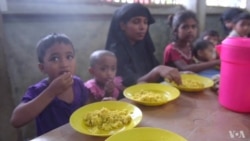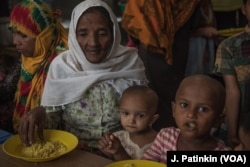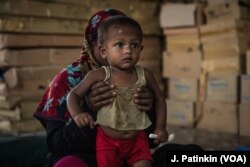Each morning, in a small Bangladeshi kitchen on the edge of the world’s largest refugee camp, a group of cooks stir rice, lentils, spices, and vitamin powder in steaming cauldrons to serve to thousands of hungry Rohingya refugees.
More than 700,000 ethnic Rohingya Muslims arrived in Bangladesh last year from neighboring Myanmar, escaping what the United Nations has called ethnic cleansing by Myanmar’s army, an allegation Myanmar denies.
Upon arrival in Bangladesh, many of the refugees were destitute, starving after fleeing army attacks on their villages.
But nearly nine months later, hunger persists for the Rohingya in Bangladesh, even though aid groups hold regular food distributions.
As a result, many families depend on the hot meals handed out at this kitchen by the Action Against Hunger aid group in the town of Ukhiya. The group also provides biscuits to children to take home after their meal to further supplement their diets.
One regular visitor to the kitchen is Abdu Sobee, who says he comes almost every day with his brother’s children.
“I need money to buy fish, vegetables, and chili to cook,” he explains, while his two nieces scoop handfuls of yellow rice into their mouths. “I don’t have this. Where will I get it? So I brought my children here because they give food for free.”
Despite the free lunches, not everyone is able to stay healthy.
In the camps, one-fifth of Rohingya children younger than 5 are malnourished, with 12 percent suffering from severe stunting as a result of their hunger, according to Action Against Hunger.
Next to the busy kitchen, the aid group operates a clinic to treat stricken children.
Currently, there are 120 children enrolled at the clinic with severe acute malnutrition, the affliction’s worst form, said Dr. Jashim Uddin Akon, who runs the Ukhiya clinic. A total of 5,000 Rohingya children are receiving treatment for severe malnutrition at 15 clinics across the camps.
During VOA’s visit, a refugee named Roshida brought her 6-month-old daughter to the doctors. The skin on the child’s arms was loose; her head lolling on a thin neck.
“She was breastfeeding for two months, and now I cannot produce enough milk, so she became malnourished,” Roshida told VOA.
A clinician measured the baby’s upper arm and determined she was a severe case. They immediately started treatment, spoon-feeding the child a high energy peanut paste mixed with water.
The baby may recover after a few weeks of this daily treatment, but the deeper problem is that Roshida herself is not fully healthy.
“I cannot produce milk because I cannot eat well,” Roshida said. “I only depend on handouts of rice. If I only eat the handouts, how will I produce milk?”
Roshida says the major issue is that she has no money to buy extra food to supplement the basic diet provided by aid groups. Her husband has a job in the refugee camp, but isn’t paid for his work. Bangladesh’s government prohibits Rohingya refugees from paid employment.
“My husband is an Islamic teacher. He’s taught for free for three months,” she said. “That’s no money.”
Recently, the World Food Program launched an initiative to close this gap. WFP’s basic food distributions include only rice, lentils and oil — hardly a balanced diet.
To fix this, WFP now gives vouchers to refugee families, which they can redeem in local markets for up to 19 different food items, including fresh vegetables, chilies, eggs, and fish, in addition to the staple rice and lentils.
Still, many refugees haven’t received the vouchers yet. With no work, another option would be to return to Myanmar, where Rohingya once had enough food. But Roshida says this is impossible.
“I’m not going back, because if we return, they will give us trouble again. We need to get our rights first. We are here in Bangladesh for justice. If we don’t get it, why will we go back?”
The past violence in Myanmar affects the nutrition of babies in another way: Mothers who suffer mental trauma from last year’s attacks struggle to properly care for their children, Akon said.
“They are not psychologically well. They have trauma. They lost their house. They lost their country. They lost their relatives,” he said. “When a mother is psychologically affected, the mothers don’t give proper caring to the babies.”
For Rohingya mothers, keeping their children well fed requires more than food handouts.















